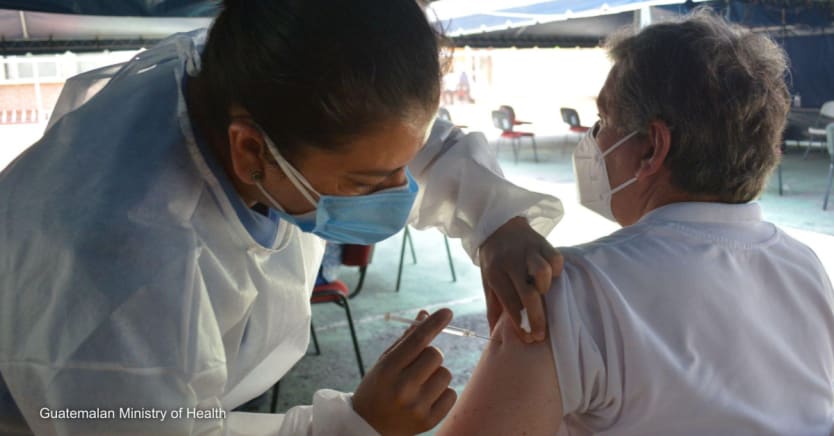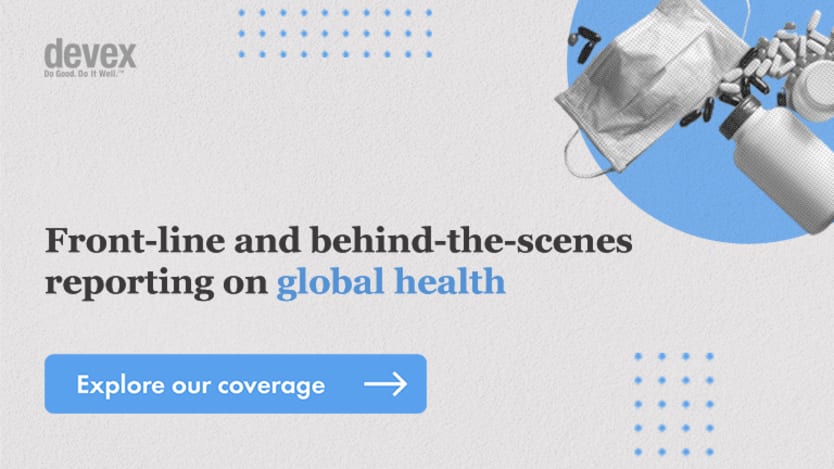
GUATEMALA CITY — Nearly three months after receiving its first vaccine shipment, Guatemala has fully inoculated less than .2% of its estimated 18 million citizens against COVID-19.
A confluence of factors — some that the country can control and some it cannot — have led Guatemala to have one of the slowest vaccination rates in Central America. The global squeeze on vaccine supply, domestic regulations, and logistical and budgetary hurdles all mean much of the population is unlikely to receive a shot anytime soon.
The country is participating in COVAX, the global vaccine equity platform designed to help nations vaccinate 20% of their populations by the end of 2021 — which would amount to nearly 4 million people in Guatemala. It has received two COVAX shipments so far; its first — 81,600 doses on March 11 — was the third shipment from COVAX to the Americas, and a second batch of 321,600 doses from the facility arrived on April 29.
But from the beginning, the Guatemalan population has found its expectations out of step with the reality of how quickly doses can be obtained and administered. Oscar Barreneche, Pan American Health Organization representative in Guatemala, said the government faced backlash for not being able to deliver doses on a timeline originally set out by President Alejandro Giammattei earlier this year.
“There was a perception that Guatemala was actually lagging behind. … Back in February [and] March, the hottest topic for our country was when, how many, and how much people were vaccinated,” Barreneche said. “At that moment, we were counting the hours.”
Sign up for Devex CheckUp
The must-read weekly newsletter for exclusive global health news and insider insights.
He said the pressure on both the Health Ministry and PAHO to deliver vaccines was enormous — even though neither entity had a say in when or how many COVAX doses would arrive.
PAHO has supported the Guatemalan government in developing its national vaccination plan and has also helped with enhancing testing capacity, safety measures to minimize the disease’s spread, and the development of a COVID-19 dashboard to increase data transparency and increase public confidence.
In addition to COVAX shipments, Guatemala has received bilateral vaccine donations: 200,000 doses from the government of India and 4,000 from Israel. It has also signed a contract for 16 million doses of Russia’s Sputnik V vaccine, of which it has received two shipments so far: 50,000 doses on May 5, and another 50,000 last week.
Such bilateral deals will become even more critical as the reverberations of India’s COVID-19 surge continue. Serum Institute of India is the world’s largest vaccine producer and supplies doses to COVAX, but the country has blocked vaccine exports as it struggles to contain its domestic outbreak. The company doesn’t anticipate fulfilling its existing commitments to COVAX until at least October — meaning it’s unclear when Guatemala will receive another COVAX shipment.

Legislative hurdles and capacity challenges
Although Guatemala began preparing for its COVID-19 vaccination campaign last year by starting the paperwork to join COVAX in July, a domestic law on the books for years restricted it from entering into bilateral deals to procure more doses directly from drug companies.
“It was only until the law was changed in January that Guatemala was able to approach … the manufacturers,” Barreneche said. “Of course, when Guatemala arrived to try to buy in the market of very limited supply to huge demand, they arrived [at] the bottom of the queue.”
Other domestic regulations regarding indemnification mean the country is also seen by some manufacturers as a flawed partner for procurement deals. Because Guatemala is a self-financing country within COVAX — it has paid $10 million so far — it doesn’t benefit from the facility’s indemnification provisions.
“The negotiations with vaccine producers are very harsh for COVID because the vaccine producers are demanding a very strict legal framework in terms of indemnization of victims of adverse events,” said Marc Rondy, PAHO immunization focal point in Guatemala. For this reason, he added, some vaccine producers may prefer to sell to other countries instead.
Although Guatemala has extensive experience with wide-scale childhood vaccination campaigns — its measles vaccine efforts successfully eradicated that disease domestically in 1998, with just isolated cases now — the country has never before embarked on a mass vaccination campaign of adults. Its past success came through participating in the Revolving Fund for Access to Vaccines, an existing mechanism run by PAHO that facilitates access to all types of vaccines by negotiating drug prices on behalf of countries.
Guatemala’s vaccine doses are managed by the National Biological Center, which stores them under refrigeration at its facility in Guatemala City. The country’s public health areas — jurisdictions that are responsible for administering health care throughout Guatemala’s departments — then retrieve doses in vehicles with the appropriate cold chain and transport them.
The 29 health areas are then responsible for administering the shots, Gladys Cruz, immunization program administrator at the National Biological Center, told Devex. She said the country’s 340 health centers were scheduled to open as COVID-19 vaccination sites last week.
“Distribution is done according to demand in the health areas,” Cruz said. “Right now, we’re sending out shipments every single day.”
From COVAX, Guatemala received doses of AstraZeneca’s vaccine, which must be stored at a temperature from 2-8 degrees Celsius. The country’s cold chain is well equipped to maintain the doses, since other kinds of vaccines distributed domestically require the same storage temperature.
But Sputnik V’s cold chain requirements pose a challenge: The vaccine must be stored at minus 20 degrees Celsius, and doses need to be thawed just before administration. It does have the advantage of being packaged in single doses, Rondy said, so vaccination sites are not left trying to administer leftover doses from a larger vial that must be used before expiration.
“In theory, you will lose less doses because you can program more easily. But the tricky part is … you need very large volumes of frozen capacities to store these doses. … In a country where you don’t have such a great capacity at minus 20 [degrees], it’s not ideal,” Rondy said.

Funding and registration roadblocks
Guatemala allocated additional money to buy COVID-19 doses in January when it changed the law restricting procurement. But those funds do not cover costs associated with administering the vaccine — for personal protective equipment, staff time, storage, and transportation, among others — restricting the company’s capacity to efficiently get shots in arms.
Guatemala’s vaccination campaign began with health workers, whom Barreneche said were the “easy catch” population because they are concentrated in health facilities.
But beginning to vaccinate the rest of the general population by age groups is much more difficult. The country is using an online platform to allow citizens who qualify to register for a vaccination appointment, posing challenges for those who don’t have internet access or are not literate or tech savvy.
“When Guatemala arrived to try to buy in the [COVID-19 vaccine] market of very limited supply to huge demand, they arrived [at] the bottom of the queue.”
— Oscar Barreneche, Pan American Health Organization representative in GuatemalaRecognizing these accessibility limitations, Rondy said the government began setting up registration portals at storefronts around the country where people can sign up for appointments in person. Registration also requires a certain type of ID card that older Guatemalans may not have, so the government began allowing those who do have IDs to register friends or family members with their cards.
While there isn’t a strong anti-vaccination community in Guatemala, the Guatemalan Red Cross is supporting the government to counter vaccine misinformation and increase uptake, according to Fredy Reynosa, coordinator of the organization’s COVID-19 response. They are working to understand what might cause someone to hesitate to receive a vaccine and address those concerns.
Per Guatemala’s contract with Russia, doses of Sputnik V are set to arrive when they’re available, a spokesperson for the Health Ministry told Devex. This can pose challenges for the vaccine’s distribution schedule because the two required doses are different formulations and are supposed to be administered three weeks apart. Since supply is not expected to keep pace with that timeline, Guatemala has been advised it can space out doses by nine weeks, Rondy said.
He said he believes Guatemala will administer all its doses before they go bad, with the first AstraZeneca shipment expiring at the end of June. The Sputnik V vaccine has a storage life of six months. PAHO is working with the Health Ministry to develop a dashboard for tracking how many first and second doses will be needed at each of the health centers.
Guatemala is currently reporting that it is vaccinating over 11,000 people per day. At this rate, it will take about 10 months to administer enough doses for an additional 10% of the population.
“It’s a challenge to make sure that they are all used on time and that every person receiving a first dose will have a second dose,” Rondy said. “They have such a strong auditing system here in terms of vaccine doses that everybody is very much aware of that and everybody is very conscious about the nonwastage of the doses.”









